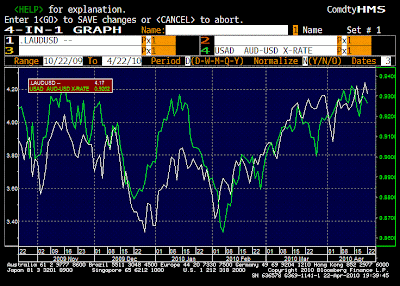| The Only Gold Indicator You Need |
| By Dr. Steve Sjuggerud |
| Wednesday, April 28, 2010 |
"So… where's the big gold bull market?" I asked John Doody over lunch yesterday.
John writes the excellent Gold Stock Analyst newsletter, where he takes a deep look into gold and the major gold stocks every month. Before starting the newsletter in the early 1990s, John was an economics professor. Right now, John and I are at a conference on Maryland's Eastern Shore.
"John, if gold is so great now, then why hasn't it soared this year?" I asked him. "It's only up like 5%."
John replied. "That's a good question… In my opinion, the primary driver of the gold price is real interest rates that investors earn on their cash."
In short, if investors earn nothing on their cash, then gold goes up. If investors earn high rates of interest on their cash, then gold goes down. As the chart below shows, that's the only gold indicatory you need to know.
In short, if investors earn nothing on their cash, then gold goes up. If investors earn high rates of interest on their cash, then gold goes down. As the chart below shows, that's the only gold indicatory you need to know.
Importantly, we're talking about the "real" rate of interest – after inflation. John defines the real interest rate as the interest rate on risk-free 90-day Treasury bills MINUS the inflation rate. That's a good estimate of your "real" return on cash.
As John explained, when the real interest rate is negative – when inflation is higher than risk-free interest – "cash loses purchasing power and buys fewer goods than it bought earlier in the year. When that happens, for protection, investors buy gold and drive its price higher."
Now, take another look at the chart. John explained, "Today's gold bull market and 1970s gold bull market were eras of negative real interest rates. But importantly, for 2010 to date, the real interest rate has been barely negative, as shown by the chart's red-circled area."
With the real interest rate at about 0%, gold isn't moving anywhere. And John pointed out that the Fed rarely raises interest rates as elections approach. So interest rates should stay where they are.
But eventually, John says, "A pickup in the economy will be the key to higher inflation. With the U.S. economy slowly on the mend, we could see inflation. Real interest rates would go negative and gold would rise."
One thing I like about John is, he's not the typical gold bug. He's not taking some moral stand against the government or digging a bunker full of freeze-dried food.
John simply looks at the facts. The facts say you need to own gold when the "real" interest rate is negative… almost regardless of the what's in the news.
His work shows that gold goes up when the bank's paying you nothing. That's where we are now… and that's what you need to know. John believes if the economy starts to recover before the election and inflation shows its head, the situation could get better from here for gold.
In short, gold looks good now, with low rates. And it could look better soon…
Invest accordingly,
Steve.
As John explained, when the real interest rate is negative – when inflation is higher than risk-free interest – "cash loses purchasing power and buys fewer goods than it bought earlier in the year. When that happens, for protection, investors buy gold and drive its price higher."
Now, take another look at the chart. John explained, "Today's gold bull market and 1970s gold bull market were eras of negative real interest rates. But importantly, for 2010 to date, the real interest rate has been barely negative, as shown by the chart's red-circled area."
With the real interest rate at about 0%, gold isn't moving anywhere. And John pointed out that the Fed rarely raises interest rates as elections approach. So interest rates should stay where they are.
But eventually, John says, "A pickup in the economy will be the key to higher inflation. With the U.S. economy slowly on the mend, we could see inflation. Real interest rates would go negative and gold would rise."
One thing I like about John is, he's not the typical gold bug. He's not taking some moral stand against the government or digging a bunker full of freeze-dried food.
John simply looks at the facts. The facts say you need to own gold when the "real" interest rate is negative… almost regardless of the what's in the news.
His work shows that gold goes up when the bank's paying you nothing. That's where we are now… and that's what you need to know. John believes if the economy starts to recover before the election and inflation shows its head, the situation could get better from here for gold.
In short, gold looks good now, with low rates. And it could look better soon…
Invest accordingly,
Steve.
P.S. John has written Gold Stock Analyst for over a dozen years. He delivers the facts on gold each month, covering 75 precious metals stocks. His "Top Ten" list has an incredible track record of success. For more on Financial Forecast Free Newsletter, click here.

























